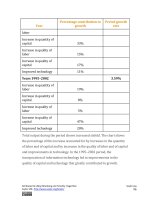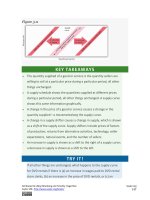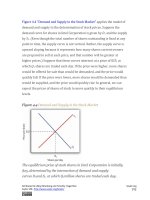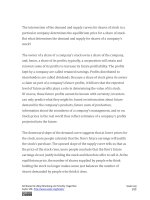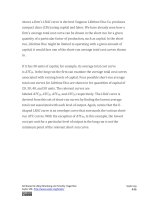Authors libby rittenberg 701
Bạn đang xem bản rút gọn của tài liệu. Xem và tải ngay bản đầy đủ của tài liệu tại đây (291.03 KB, 1 trang )
Saving adds to a household’s wealth. Dissaving reduces it. Indeed, a
household’s wealth is the sum of the value of all past saving less all past
dissaving.
We can think of saving as a choice to postpone consumption. Because
interest rates are a payment paid to people who postpone their use of
wealth, interest rates are a kind of reward paid to savers. Will higher
interest rates encourage the behavior they reward? The answer is a
resounding “maybe.” Just as higher wages might not increase the quantity
of labor supplied, higher interest rates might not increase the quantity of
saving. The problem, once again, lies in the fact that the income and
substitution effects of a change in interest rates will pull in opposite
directions.
Consider a hypothetical consumer, Tom Smith. Let us simplify the analysis
of Mr. Smith’s choices concerning the timing of consumption by assuming
that there are only two periods: the present period is period 0, and the
next is period 1. Suppose the interest rate is 8% and his income in both
periods is expected to be $30,000.
Mr. Smith could, of course, spend $30,000 in period 0 and $30,000 in
period 1. In that case, his saving equals zero in both periods. But he has
alternatives. He could, for example, spend more than $30,000 in period 0
by borrowing against his income for period 1. Alternatively, he could
spend less than $30,000 in period 0 and use his saving—and the interest
he earns on that saving—to boost his consumption in period 1. If, for
example, he spends $20,000 in period 0, his saving in period 0 equals
$10,000. He will earn $800 interest on that saving, so he will have $40,800
to spend in the next period.
Attributed to Libby Rittenberg and Timothy Tregarthen
Saylor URL: />
Saylor.org
701
